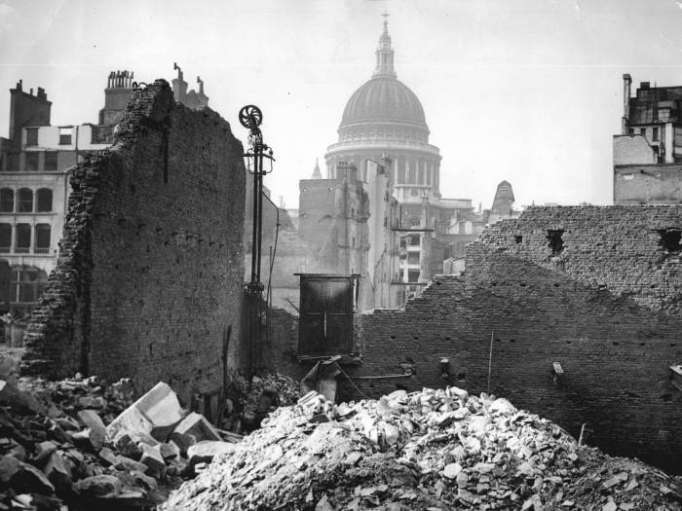His signature saw America's bold strategy for the economic rejuvenation of Europe after the Second World War enacted two months later, a steady programme of investment to rehabilitate 17 nations brought low by the conflict.
Masterminded by Secretary of State George C Marshall, who had served as the US Army's Chief of Staff during the war, the plan officially known as the Foreign Assistance Act of 1948 or the European Recovery Programme saw the US take a lead role in "restoring the confidence of the European people in the economic future of their own countries and of Europe as a whole".
The US had delivered generous quantities of aid to its beleaguered allies and former foes since VE Day, shipping 16.5m tonnes of food, primarily wheat, to Europe and Japan between July 1945 and June 1946, amounting to a sixth of its own supply and 35 trillion calories, feeding 300m people.
Seeing the need for a more systematic approach to helping Europe get back on its feet and rebuild its cities and infrastructure, Marshall announced his vision in a speech to Harvard University's graduating class on 5 June 1947.
"It is logical that the United States should do whatever it is able to do to assist in the return of normal economic health to the world, without which there can be no political stability and no assured peace," he said.
Marshall was keen to learn the lessons of the First World War, after which Weimar Germany had been largely abandoned, suffering hyperinflation and mass unemployment and creating the public anger that paved the way for Adolf Hitler's Nazis to rise to power on the promise of making Germany great again.
As an investment in international security, Marshall proposed to hand out $13bn in aid, food, fuel and machinery to Austria, Belgium, Denmark, France, Greece, Iceland, Ireland, Italy, Luxembourg, the Netherlands, Norway, Portugal, Sweden, Switzerland, Turkey, the UK and West Germany.
The handout would be distributed by the newly formed Committee of European Economic Cooperation between 1948 and 1951 and, it was hoped, lift the people of those nations out of poverty.
And the Marshall Plan worked. All of the countries participating saw an increase in their gross national product of between 15 and 25 per cent over its duration, the capital ploughed into reviving agricultural and heavy industry across Western Europe.
Britain received $2.7bn while West Germany was given $1.7bn and it has been argued that Clement Attlee's Labour government made an error in not channelling the windfall into the modernisation of British industry, allowing it to be left behind by its continental competitors in the manufacturing boom of the 1950s.
Cynics have argued that this "good deed foreign policy" also conveniently created vibrant new export markets for American produce to save the US from sliding back into depression after the nightmare decade of the 1930s but its positive impact on Europe was there for all to see.
Bomb damage to St Paul's Cathedral as a result of Second World War air raids (Frank Rust/ANL/Rex)
A more serious criticism of the plan is that it inadvertently led to the Cold War by alienating Russia.
The US was certainly concerned about the spread of messianic Soviet communism at the time and its negotiators had met with Russian Foreign Minister Vyacheslav Molotov in an attempt to secure the USSR's involvement.
But the Kremlin was suspicious of what it regarded as the US conniving to win control of Europe and prohibited its satellite states like East Germany, Czechoslovakia, Hungary and Poland from taking part.
Thereafter, "both sides... became irrevocably committed to securing their respective spheres of influence," writes historian Benn Steil in his new book on the Marshall Plan.
The USSR's rejection divided Europe neatly down the middle between capitalism and communism and saw Joseph Stalin tighten his grip on power and denounce American interventionist meddling, pushing the superpowers further apart, Steill argues.
"Years and years would pass before they found it possible to negotiate seriously again, years during which vested interests, with overwhelming stakes in the continuance of the conflict, would emerge," historian Hugh Brogan writes.
A policy of economic containment ended in military stand-off, which in turn fostered the anti-communist sentiment at home that bred the Red Scare and the persecution of public figures by Republican Senator Joseph McCarthy.
Benn Steil also makes the case that the plan failed in another of its primary goals, in that it was "aimed at aiding American military disengagement from Europe, yet ended up, through Nato [founded in 1949] making it both deeper and enduring."
Despite these complicating factors, the Marshall Plan was fundamentally a success, providing western Europe with the tools to rebuild and bringing stability when it was needed most.
George C Marshall was awarded the Nobel Peace Prize in 1953 and Brogan has called his greatest achievement "the most unambiguously and triumphantly successful of all America's post-war policies".
The Marshall Plan was a product of the same "Spirit of '45" utopian idealism that led to the founding of the NHS in Britain, a cultural moment in which the citizens of the world sincerely believed that a better tomorrow could be raised from the rubble of war, our differences put aside and a new page turned on the history of human relations.
Nato, the EU and the World Trade Organisation would all follow in its footsteps, each international body designed to bind nations in common agreement, guided by American example.
On the 70th anniversary of the Marshall Plan, President Donald Trump's move to withdraw the US from Nato and the Paris accord on climate change is doubly disheartening.
The outward-looking ambition and generosity the Marshall Plan embodied found America at its very best on the international stage, setting the tone with moral leadership and conviction.
The Independent
More about:

























-1731503623.jpg&h=190&w=280&zc=1&q=100)






















